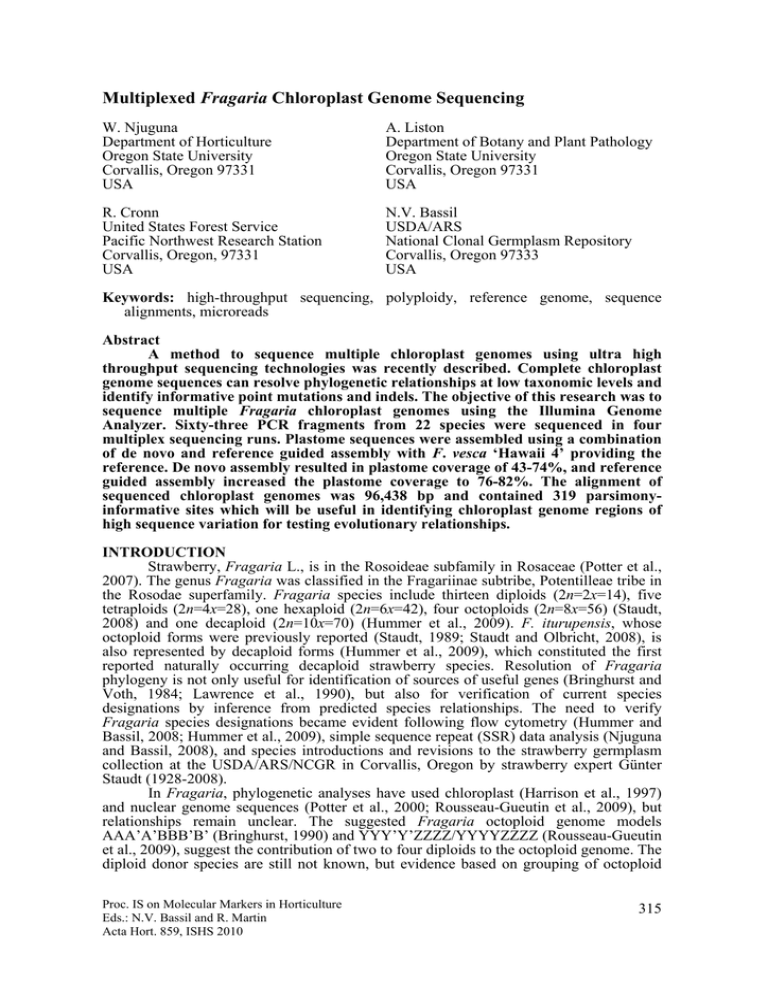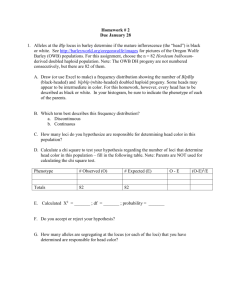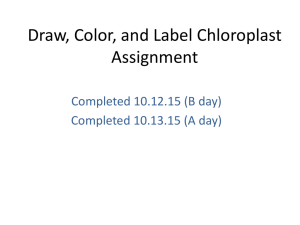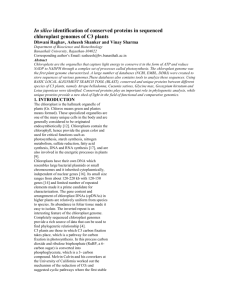Fragaria
advertisement

Multiplexed Fragaria Chloroplast Genome Sequencing W. Njuguna Department of Horticulture Oregon State University Corvallis, Oregon 97331 USA A. Liston Department of Botany and Plant Pathology Oregon State University Corvallis, Oregon 97331 USA R. Cronn United States Forest Service Pacific Northwest Research Station Corvallis, Oregon, 97331 USA N.V. Bassil USDA/ARS National Clonal Germplasm Repository Corvallis, Oregon 97333 USA Keywords: high-throughput sequencing, polyploidy, reference genome, sequence alignments, microreads Abstract A method to sequence multiple chloroplast genomes using ultra high throughput sequencing technologies was recently described. Complete chloroplast genome sequences can resolve phylogenetic relationships at low taxonomic levels and identify informative point mutations and indels. The objective of this research was to sequence multiple Fragaria chloroplast genomes using the Illumina Genome Analyzer. Sixty-three PCR fragments from 22 species were sequenced in four multiplex sequencing runs. Plastome sequences were assembled using a combination of de novo and reference guided assembly with F. vesca ‘Hawaii 4’ providing the reference. De novo assembly resulted in plastome coverage of 43-74%, and reference guided assembly increased the plastome coverage to 76-82%. The alignment of sequenced chloroplast genomes was 96,438 bp and contained 319 parsimonyinformative sites which will be useful in identifying chloroplast genome regions of high sequence variation for testing evolutionary relationships. INTRODUCTION Strawberry, Fragaria L., is in the Rosoideae subfamily in Rosaceae (Potter et al., 2007). The genus Fragaria was classified in the Fragariinae subtribe, Potentilleae tribe in the Rosodae superfamily. Fragaria species include thirteen diploids (2n=2x=14), five tetraploids (2n=4x=28), one hexaploid (2n=6x=42), four octoploids (2n=8x=56) (Staudt, 2008) and one decaploid (2n=10x=70) (Hummer et al., 2009). F. iturupensis, whose octoploid forms were previously reported (Staudt, 1989; Staudt and Olbricht, 2008), is also represented by decaploid forms (Hummer et al., 2009), which constituted the first reported naturally occurring decaploid strawberry species. Resolution of Fragaria phylogeny is not only useful for identification of sources of useful genes (Bringhurst and Voth, 1984; Lawrence et al., 1990), but also for verification of current species designations by inference from predicted species relationships. The need to verify Fragaria species designations became evident following flow cytometry (Hummer and Bassil, 2008; Hummer et al., 2009), simple sequence repeat (SSR) data analysis (Njuguna and Bassil, 2008), and species introductions and revisions to the strawberry germplasm collection at the USDA/ARS/NCGR in Corvallis, Oregon by strawberry expert Günter Staudt (1928-2008). In Fragaria, phylogenetic analyses have used chloroplast (Harrison et al., 1997) and nuclear genome sequences (Potter et al., 2000; Rousseau-Gueutin et al., 2009), but relationships remain unclear. The suggested Fragaria octoploid genome models AAA’A’BBB’B’ (Bringhurst, 1990) and YYY’Y’ZZZZ/YYYYZZZZ (Rousseau-Gueutin et al., 2009), suggest the contribution of two to four diploids to the octoploid genome. The diploid donor species are still not known, but evidence based on grouping of octoploid Proc. IS on Molecular Markers in Horticulture Eds.: N.V. Bassil and R. Martin Acta Hort. 859, ISHS 2010 315 and diploid nuclear genes (ADH, alcohol dehydrogenase; GBSSI-2 or Waxy; and DHAR, dehydroascorbate reductase) points to F. vesca L., F. mandschurica Staudt sp. nova and F. iinumae Makino (Davis and DiMeglio, 2004; Harrison et al., 1997; Potter et al., 2000; Rousseau-Gueutin et al., 2009; Senanayake and Bringhurst, 1967) as possible contributors. Based on low copy nuclear gene sequences, Rousseau-Gueutin et al. (2009) grouped Fragaria diploids into three clades. However, the diploid species within clade X were poorly resolved and the placement of F. bucharica remains unclear. The use of nuclear genes for phylogenetic analysis is complicated by polyploidy and recombination (Nishikawa et al., 2002), making the chloroplast genome an attractive option for Fragaria. Further exploitation of the chloroplast genome in Fragaria for phylogenetic analysis is warranted due its small size, non-recombinant nature, and high sequence conservation, all factors that reduce the complexity of analysis and interpretation of results. For efficient use of limited chloroplast sequence divergence, large-scale sequencing is required, and is now possible with high throughput sequencing platforms. Sequencing of multiple small genomes to high coverage depth using high-throughput sequencing platforms was recently demonstrated (Cronn et al., 2008). In this study, we used multiplex sequencing to uncover sequence divergences in the chloroplast genomes of Fragaria species. MATERIALS AND METHODS Plant Material and DNA Extraction Twenty-one of 22 wild Fragaria species, and one Potentilla villosa accession, a close relative of Fragaria in the Rosaceae family, that have been preserved at the germplasm repository in Corvallis (Table 1) were included in the study. DNA was extracted from actively-growing leaves using a modified protocol based on the PUREGENE® kit (Gentra Systems Inc. Minneapolis, MN). The DNA samples were cleaned further with Nucleon PhytoPureTM resin, a component found in the illustra Nucleon PhytopureTM kits for plant and fungal DNA extraction (GE Healthcare UK Limited, Buckinghamshire, UK). DNA quality and quantity was analyzed with a Wallac 1420 VictorV microplate reader (PerkinElmer, Waltham, MA). DNA concentration was adjusted to 3 ng/µl for PCR. Primer Selection, Design and PCR A total of 203 chloroplast primers (108 forward, 95 reverse) were screened in various logical combinations in four species to identify primer pairs that amplify >2500 bp fragments and provide maximum coverage of the chloroplast genome. Where possible, primer pairs that amplified single bands and that amplified in most or all of the species were chosen. Of the 203 primers, 141 had been used to amplify the Cucumis sativus L. chloroplast genome (Chung et al., 2007), 25 were designed from the complete genome sequence of Morus indica ‘K2’ (Ravi et al., 2006), and 36 were designed from the nearly complete chloroplast genome of F. vesca cv. Hawaii4 (http://strawberry.vbi.vt.edu/tiki­ index.php). Sixty-three primer pairs were chosen to amplify the entire chloroplast genomes of 21 Fragaria species and one Potentilla accession (list available upon request from corresponding author). Long-range PCR was carried out using PhusionTM HighFidelity DNA polymerase (New England Biolabs, Ipswich, MA). Amplifications were performed in 10 µl total reaction volumes containing 5x Phusion GC buffer, 2.5 mM of each dNTP, 10 µM of each primer, 5 U of Phusion DNA polymerase, 0.05 µl of 3% DMSO and 5 ng of DNA template. PCR product quantification was carried out using the Quant-iTTM PicoGreen® dsDNA quantification protocol (Molecular Probes, Inc. Eugene, OR) manufacturer’s specifications. Equimolar amounts of PCR products were pooled for each species to generate 1-5 µg of chloroplast DNA which was prepared for sequencing using the Illumina sample preparation kit (Illumina Inc., San Diego, CA) and the modifications of Cronn et al. (2008). Each PCR pool was sheared using nitrogen from a 316 compressed source at 42 psi for two minutes. The fragments were repaired to remove 3’ and fill 5’ overhangs before adding ‘A’ bases to the 3’ ends to allow the ligation of single ‘T’ bases on the 3’ end of the adapters. Illumina adapters modified by the addition of a three base pair barcode were ligated to the fragments; a different barcode was used for each species in a multiplex pool. DNA fragments of approximately 300 bp were isolated by cutting the fragments from a 2% low melting agarose gel and PCR was performed to enrich for the targeted fragment sizes. Fragments from five or six chloroplast genomes were then mixed in equimolar ratios at a final concentration of 10 nM per pool in each of four multiplex pools. Sequence Data Analysis After the sequencing run, raw image data for each sequencing cycle was processed into base calls and alignment files through the Illumina/Solexa Pipeline (version 0.2.2.6). Binning was carried out using the three base pair nucleotide tags. After sorting microreads into species-specific bins, the barcodes and adapter tags were removed and resulting 32 bp microreads used for subsequent analysis. Contigs of F. vesca ‘Baron Solemacher’ were assembled de novo using Velvet Assembler 0.4 (Zerbino and Birney, 2008), a hash length of 17, minimum coverage 5x, and minimum contig length of 100. The contigs were then aligned to the 135,946 bp chloroplast genome of F. vesca ‘Hawaii4’. The alignment was manually checked for errors, with insertions and deletions for a more accurate alignment. Non-target sequences from other cellular genomes were discarded and a consensus sequence was generated in Bioedit. The ‘Baron Solemacher’ sequence was 132,287 bp in length and served as the reference for subsequent analyses. The reference genome was labeled ‘FvRefv2’ and annotated using DOGMA (http://dogma.ccbb.utexas.edu/). Contigs for each of the 22 species were assembled as described for F. vesca ‘Baron Solemacher’. ‘N’s were added to the ends of the contigs from each of the 22 species to aid in distinguishing gaps in the sequence from indels in the alignment. The Nended contigs were then aligned to the FvRefv2 reference using CodonCode (www.codoncode.com) and a consensus sequence was generated in Bioedit 7.0 (www.mbio.ncsu.edu/bioedit/bioedit.html/). Gaps (but not indels) between de novo contigs were replaced with FvRefv2 sequence forming a chimeric sequence which was then used for reference guided assembly (RGA) (Shen and Mockler, in prep; http://rga.cgrb.oregonstate.edu). The resulting ‘chimeric reference sequence’ was different for each species. The settings used for RGA were ≤2 mismatches per microread, Q-values ≥20, read depth ≥5, error rate of 0.06 and SNP acceptance requiring ≥70% of reads to be in agreement. The online software MAFFT (http://align.bmr.kyushu-u.ac.jp/mafft/software/) was used to align the assemblies from the RGA output. The MAFFT alignment (134,000 bp) was manually checked for misalignments and sequencing errors. The aligned sequences were searched for the presence of primer sequences, and their positions and amplicon sizes in Fragaria were noted. Nucleotide positions corresponding to primer positions were eliminated from the alignment because most of the primers used for PCR were not of Fragaria origin. Indels were scored for future phylogenetic analysis and summary statistics related to the number of reads in each amplicon were manually calculated. RESULTS AND DISCUSSION The 63 primer pairs used in this study were designed to amplify fragments ranging in size from 871-5317 bp with an average size of 3044 bp. Their genome positions and sizes were based on the completely sequenced chloroplast genome of Nicotiana tabacum L. (Shinozaki et al., 1986). Primer sequence positions in FvRefv2 allowed the calculation of amplicon sizes in Fragaria. Based on these calculations, the Fragaria chloroplast genome is estimated to be 131,860 bp, which is smaller than that of N. tabacum (155,844 bp). Based on FvRefv2, the mean amplicon size was 3045 bp, median size was 3014 bp, and the size of amplified fragments ranged from 845-5386 bp. Of the 126 primers used to 317 amplify the Fragaria and Potentilla chloroplast genomes, 20 sequences (forward and/or reverse) were not found in FvRefv2. The missing primer sequences are attributed to sequencing failures, the smaller size of the chloroplast genome of Fragaria, and mutations in primer target regions. Since PCR success was verified by agarose gel electrophoresis before sequencing, amplified products that were not detected in the sequenced chloroplasts could represent non-target amplification of nuclear and/or mitochondrial genome regions. The median number of reads obtained for each amplicon in the different species ranged from 0-56 while the average was 16. Amplicons with median numbers ≤5 may indicate low quantity in the PCR amplicon pool for the species due to underestimation of PCR product quantity or amplification of non-target DNA. Amplicons with average median values of <5 reads per base pair corresponded to those flanked by missing primer sequences. This further indicates non-target amplification of some regions of the chloroplast genome. Manual improvement of the MAFFT alignment by removing regions of possible sequencing errors, primer sequences, non-target amplicon sequences, and the addition of insertions and deletion reduced the length of the aligned sequence from 134,000 to 96,390 bp. Forty-eight indels were noted in the aligned chloroplast sequences. The final alignment of sequenced genomes was 96,438 bp including indels, and contained 995 variable sites and 319 parsimony-informative sites. The limited variation we observed in the chloroplast genome of Fragaria represents less than 1% of the MAFFT alignment, consistent with the low variability noted in previous studies (Harrison et al., 1997; Potter et al., 2000). However, the few variable sites observed in this study will prove useful in resolving relationships among Fragaria species as well as in identifying variable regions in the chloroplast genome that may be used as DNA barcodes. Summaries of sequencing run output and sequencing analysis results are provided (Table 2). The genome coverage obtained with RGA (36-82%) was significantly higher than that obtained with de novo assembly using Velvet Assembler (version 0.4) (7-74%) (p value=0.00001). RGA aligns microreads to their best match on a reference genome and thus higher genome coverage was expected. The genome coverage based on RGA results for three of the species, F. bucharica (69%), F. moschata (46%), and F. nubicola (36%) was significantly lower than for the remaining species (p value=0.04). The low coverage observed in these three species could be due to errors during PCR product pooling or in preparation for sequencing. CONCLUSIONS Multiplex sequencing of Fragaria chloroplast genomes resulted in genome coverages ranging from 73-82% in 16 species, and low genome coverage in F. bucharica, F. moschata and F. nubicola. To reduce non-specific and null amplifications and errors in amplicon pooling concentrations, the samples with low coverage will be sequenced directly using genomic DNA preps as will four additional samples including F. iinumae, F. pentaphylla, F. chiloensis and F. moupinensis that had genome coverage values ≤76% from RGA. This may help to complete the dataset enabling more comprehensive phylogenetic analysis. A preliminary phylogenetic analysis (not shown) supported the three diploid clades of Rousseau-Gueutin et al. (2009) with bootstrap values ranging from 98-100%. The majority of the remaining nodes were supported by 100% bootstrap values, which are higher than those in previous Fragaria phylogenetic studies using molecular markers and nuclear and chloroplast genome sequences (Harrison et al., 1997; Potter et al., 2000; Rousseau-Gueutin et al., 2009). The results of this study will be useful in identifying chloroplast genome regions of high sequence variation for testing evolutionary relationships in future studies such as DNA barcoding. ACKNOWLEDGMENTS The authors thank Theodore Bunch, Michael Dossett, April Nyberg and Sarah Sundholm for invaluable technical support. We also thank Matthew Parks for assistance with advice in setting up experiments, Dr. Brian Knaus for laboratory and data analysis 318 assistance and, Mark Dasenko and Chris Sullivan (OSU, Center for Genome Research and Biocomputing) for sequencing and data management support. Literature Cited Bringhurst, R.S. 1990. Cytogenetics and evolution in American Fragaria. HortScience 25:879-881. Bringhurst, R.S. and Voth, V. 1984. Breeding octoploid strawberries. Iowa State Journal of Research 58:371-381. Chung, S.M., Gordon, V.S. and Staub, J.E. 2007. Sequencing cucumber (Cucumis sativus L.) chloroplast genomes identifies differences between chilling-tolerant and ­ susceptible cucumber lines. Genome 50:215-225. Cronn, R., Liston, A., Parks, M., Gernandt, D.S., Shen, R. and Mockler, T. 2008. Multiplex sequencing of plant chloroplast genomes using Solexa sequencing-by­ synthesis technology. Nucleic Acids Res. 36:122. Davis, T.M. and DiMeglio, L.M. 2004. Identification of putative diploid genome donors to the octoploid cultivated strawberry, Fragaria ×ananassa. Plant and Animal Genome XII. San Diego, CA, January 10-14. (poster #603). Harrison, R.E., Luby, J.J. and Furnier, G.R. 1997. Chloroplast DNA restriction fragment variation among strawberry (Fragaria spp.) taxa. J. Amer. Soc. Hort. Sci. 122:63-68. Hummer, K. and Bassil, N. 2008. Unexpected polyploidy in wild Asian strawberries HortScience 43:1187. Hummer, K., Nathewet, P. and Yanagi, T. 2009. Decaploidy in Fragaria iturupensis Staudt (Rosaceae). Amer. J. Bot. 96:713-716. Lawrence, F.J., Galleta, G.J. and Scott, D.H. 1990. Strawberry breeding work of the United States Department of Agriculture. HortScience 25:895-896. Nishikawa, T., Salomon, B., Komatsuda, T. and von Bothmer, R. 2002. Molecular phylogeny of the genus Hordeum using three chloroplast DNA sequences. Genome. 45:1157-1166. Njuguna, W. and Bassil, N. 2008. A microsatellite fingerprinting set for strawberry, Fragaria L. HortScience 43: 915. Potter, D., Eriksson, T., Evans, R.C., Oh, S., Smedmark, J.E.E., Morgan, D.R., Kerr, M., Robertson, K.R., Arsenault, M., Dickinson, T.A. and Campbell, C.S. 2007. Phylogeny and classification of Rosaceae. Plant Syst. Evol. 266:5-43. Potter, D., Luby, J.J. and Harrison, R.E. 2000. Phylogenetic relationships among species of Fragaria (Rosaceae) inferred from non-coding nuclear and chloroplast DNA sequences. Syst. Bot. 25:337-348. Ravi, V., Khurana, J., Tyagi, A. and Khurana, P. 2006. The chloroplast genome of mulberry: complete nucleotide sequence, gene organization and comparative analysis. Tree Gen. Genom. 3:49-59. Rousseau-Gueutin, M., Gaston, A., Aïnouche, A., Aïnouche, M.L., Olbricht, K., Staudt, G., Richard, L. and Denoyes-Rothan, B. 2009. Tracking the evolutionary history of polyploidy in Fragaria L. (strawberry): New insights from phylogenetic analyses of low-copy nuclear genes. Mol. Phylogen. Evol. 51:515-530. Senanayake, Y.D.A. and Bringhurst, R.S. 1967. Origin of Fragaria polyploids. I. Cytological analysis. Amer. J. Bot. 51:221-228. Staudt, G. 1989. The species of Fragaria, their taxonomy and geographical distribution. Acta Hort. 265:24-31. Staudt, G. 2008. Strawberry biogeography, genetics and systematics. In: VI International symposium, 3-7 March 2008, Huelva. Staudt, G. and Olbricht, K. 2008. Notes on Asiatic Fragaria species V: F. nipponica and F. iturupensis. Botanische Jahrbücher für Systematik 127:317-341. Zerbino, D. and Birney, E. 2008. Velvet: algorithms for de novo short read assembly using De Bruijn graphs. Genome Res. 18:821-829. 319 Tables Table 1. Taxa, PI numbers, ploidy and origin of Fragaria accessions used for chloroplast sequencing. Taxon F. orientalis F. iinumae F. nipponica F. virginiana F. iturupensis F. viridis F. ×bifera F. nilgerrensis F. bucharica F. vesca F. moschata F. daltoniana F. chiloensis F. tibetica F. pentaphylla F. gracilis F. corymbosa F. ×ananassa ssp. cuneifolia F. chinensis F. mandschurica F. nubicola 320 PI number PI 551864 PI 637963 PI 637975 PI 612492 PI 641091 PI 616857 PI 616613 PI 616672 PI 551851 PI 551507 PI 551528 PI 641195 PI 612318 PI 651567 PI 651568 CFRA 1908 CFRA 1911 PI 551805 PI 616583 CFRA 1947 PI551853 Ploidy 4x 2x 2x 8x 10x 2x 2x 2x 2x 2x 6x 2x 8x 4x 2x 4x 4x 8x 2x 2x 2x Origin Russian Federation Japan Japan Canada Russian Federation Sweden France China Pakistan Germany France China Ecuador China China China China United States China Mongolia Pakistan Table 2. Illumina sequencing output and data summary, including the tag (3 bp barcode used for each sample), the multiplex pool for each sample, the sum of microreads, average and median number of reads for each base pair position, de novo and reference guided assembly (RGA) coverage. Taxon Tag Lane/pool Microreads F. iinumae F. corymbosa F. tibetica F. viridis F. daltoniana P. villosa F. nipponica F. bucharica F. moschata F. iturupensis F. nubicola F.×ananassa ssp. cuneifolia F. gracilis F. virginiana F. pentaphylla F. chiloensis F.×bifera F. mandschurica F. chinensis F. vesca F. orientalis F. nilgerrensis acg agc ccc ctg gta tac gat tca ggg tgc tgc aac atg cac gct ttg acg agc ccc ctg gta tac FragA 607,838 1,600,377 1,193,513 962,316 621,757 1,133,877 579,426 295,691 871,489 1,921,668 1,209,936 864,943 305,281 727,536 757,266 348,758 470,616 682,461 820,618 647,651 866,894 1,042,414 FragB FragC FragD Average reads/bp 51.62 205.47 161.60 113.77 80.72 112.33 47.95 7.37 72.70 121.96 92.35 108.11 28.00 79.40 21.93 19.45 43.80 72.96 107.22 87.51 97.79 137.55 Median reads/bp 6 50 14 19 15 4 10 2 0 13 0 12 8 14 4 3 7 10 17 8 14 13 De novo coverage (%) 43 74 65 68 64 54 58 10 10 61 7 64 51 63 27 22 48 55 69 51 63 62 RGA coverage (%) 76 82 80 80 81 73 80 69 46 78 36 82 79 79 75 73 79 81 81 79 79 80 321 321 322





